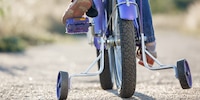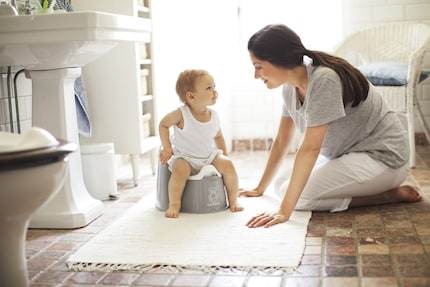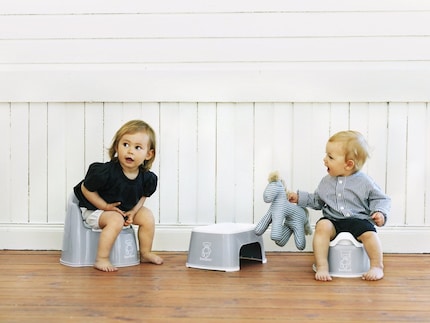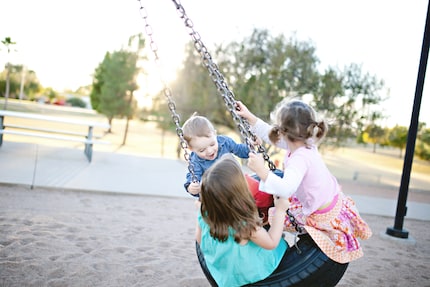
Guide
11 family purchases you can live without
by Katja Fischer

Toilet training for the little ones is just as important as for the grown-ups. These tips will help you get rid of nappies and (hopefully) keep your child dry.
My colleague Natalie Hemengül wrote an entertaining article on the topic "What I learnt during toilet training". The article got many readers thinking. Me too. Funnily enough, I wasn't thinking about my toilet training, but about getting my daughter dry.
It's about time. My little one needs to be dry! Why is that? She shows great interest in the potty in her grandparents' bathroom. When we parents sit on the toilet, she sits in front of it, stares at us and says: "What are you doing, Mummy? ". An important point for me: I want to finally reduce the pile of nappies that I dispose of every week. My mind is made up. As of today, our bathroom also has a "Häfi" (potty).
I make this decision a few months before her second birthday. Three weeks later, the time has come. She deliberately goes potty. She is now over three years old and manages to stay dry during the day. She's not ready for the night yet.
Signs
Different signs indicate when a child should or could go to the toilet. Some children go of their own accord, others are encouraged to do so. My little one, for example, often withdrew into a corner, was focussed and didn't make a sound. We gradually introduced her to the potty. Other clues can be:

Timing
The earlier you start, the more difficult the transition from nappy to potty will be. Children do not (yet) understand the action and express themselves unclearly. Nevertheless, there are parents who start potty training as soon as the baby can sit.
In my opinion, a good start is when the child is interested in the potty and also recognises that it has wet its nappy. Don't expect too much at the beginning, because the poo is usually already done before you realise it or reach the "Häfi". Be patient and support your child during this weaning phase. At some point, the day will come when you can celebrate your child's first sense of achievement with them.
It should be fun
Getting dry is a milestone in your development. That's why it's important that you don't push, embarrass or even threaten your child. On the contrary, they should enjoy it. A pleasant environment with the right equipment (pot, step stool, toilet seat, toilet paper with a child's motif) helps with this. It is also supportive if the little ones can play with the potty in between without pressure.

Small rewards at the beginning
To increase the fun factor, we have added a small reward to the dry spell, for example. Every time she told us she had to go to the toilet and did her business on it, she got a few Smarties. This convinced our chocolate mouse and she clearly enjoyed it.
Big reward at the end
After a few weeks, we went one step further. The Smarties were dropped and she could collect glittery stickers instead. One day without a nappy resulted in a glitter sticker. Together we decided that with ten stickers, which she was allowed to choose herself, she would get the doll's pram she wanted. After about three weeks, she had collected all the stickers and received the present. Since then, she has been dry with a few exceptions.
The right path counts
Many roads lead to Rome. The same goes for getting dry. What worked for our daughter doesn't necessarily work for your child. Find the right way and give it time. Maybe there's a tip here that will help you get your child dry:
Finally dry and now this: as soon as you've left the house or arrived at the playground, it's "Mum, I have to go to the toilet". Especially in the early stages, it will happen more often that your child urgently needs to go to the toilet even though there isn't one nearby.
As we learnt in Natalie's article above, we should never hold anything back. The body tells us when it needs to go out. Stay patient in these situations and find a suitable place away from your child where they can relieve themselves briefly. Alternatively, takeaway potties are also available.

As different as children are, as different can be the process of becoming dry. Maybe you've already been through it and can give the other parents some more tips. Or do you have another question? Use the comment field. For more tips, tricks and topics relating to babies and toddlers, follow my profile.
I’m the cook, cleaner, police officer, nurse, entertainer, motivator, author, storyteller, coach, organiser, chauffeur, lawyer and judge. To put it simply, I’m a mum to a daughter and not just a (Content) Manager at the office but also at home.
Practical solutions for everyday problems with technology, household hacks and much more.
Show all